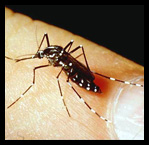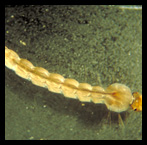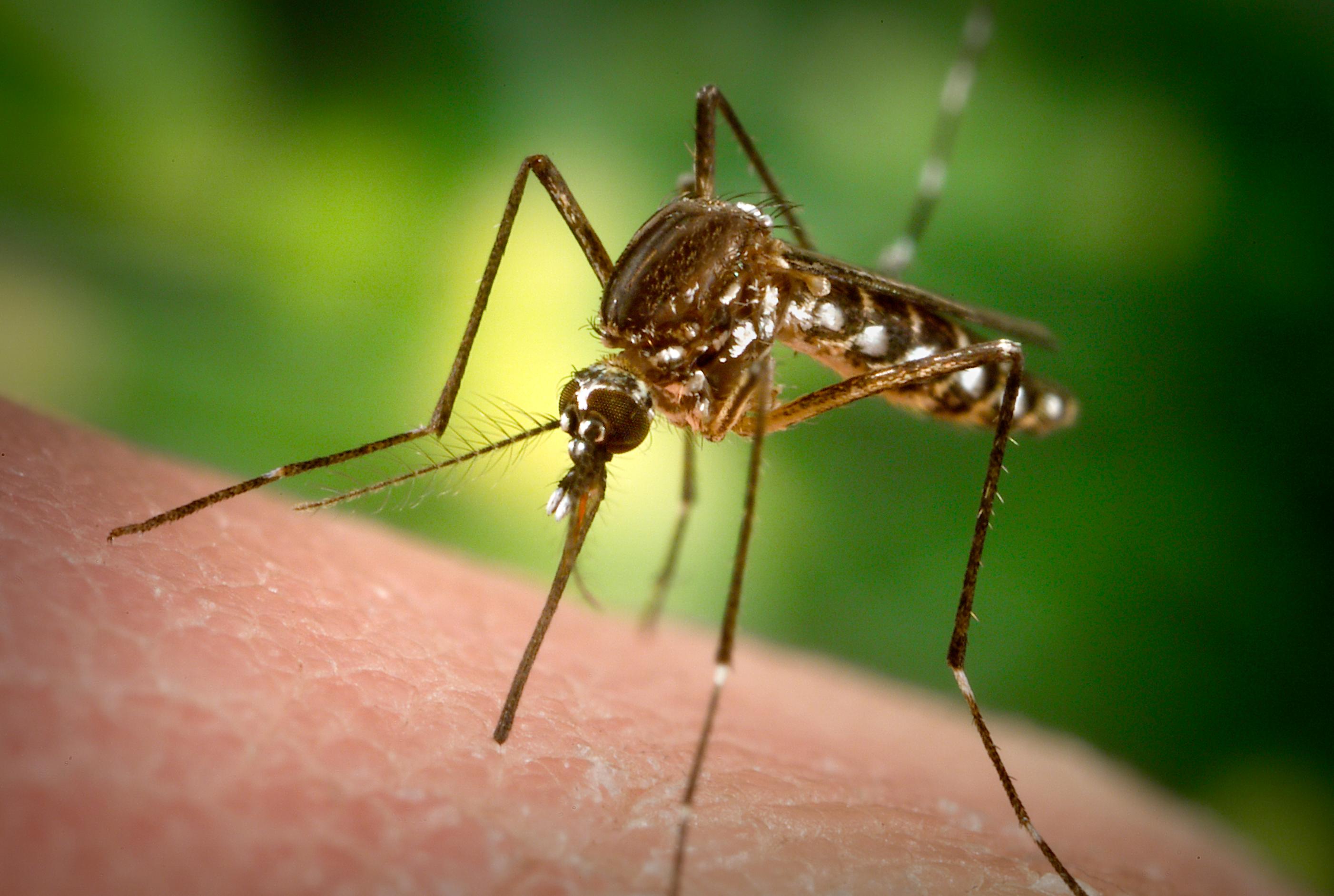Description:
The mosquito lifecycle is completed in an aquatic (egg, larva, and pupa) and terrestrial environment (adults). The aquatic environment can vary from temporary surface water (tidal pools in salt marshes, rain pools, and flood water) to permanent surface water (pools, stream, swamps, and lakes), as well as natural and artificial water-holding containers (tree holes, leaf axils, fruit husks, mollusk shells, drinking water pots, and discarded tires).
Eggs are laid by a female mosquito either on or in the water, or on a solid substrate that will become under water at some point. Location of egg laying depends on the genera of mosquito. How the eggs are laid also varies by genera, some scatter their eggs on the water surface, some attach them to a substrate, some lay them in clumps that resemble boat-like rafts on the water surface, and others are laid in radial clusters attached to vegetation underwater.
The pupae are typically located at the water’s surface for a couple days before adult emergence.
Upon emergence, all adult mosquitoes will take a sugar meal (nectar). The male adults emerge a day earlier and wait at the water’s surface for the females. The female mosquitoes will consume a bloodmeal when it’s time to produce eggs.
Animals Attacked:
All warm-blooded vertebrates
Veterinary Impact:
Large populations of mosquitoes can cause irritation and extensive blood loss to livestock; this can result in reduced productivity and sometimes even death.
Mosquitoes have been implemented to carry many different disease pathogens and viruses that infect vertebrates.
Disease Transmission:
Eastern Equine Encephalomyelitis (EEE) virus is an important cause of mortality of horses and other equids, caged pheasants, whooping cranes and emus. The virus occurs in endemic areas of the US in Texas, along the Gulf Coast and Atlantic seaboard to Massachusetts. If a horse contracts the virus, it will succumb to the infection within 2-5 days. Signs of infection begin with abnormal behavior and a high fever, and then the horse will drop to the ground and lapse into a coma before death. Few horses will survive an infection that has these acute symptoms. EEE has been reported in dogs and pigs as well. Cases of EEE begin to occur in Texas in spring and summer. Immunizations are available to reduce the chances of horses contracting EEE.
Western Equine Encephalomyelitis (WEE) virus occurs in horses almost every summer within the viruses range. Immunizations are available to reduce the chance of horses contracting WEE. The last outbreak in Texas occurred in Hale County in 1965.
Venezuelan Equine Encephalomyelitis (VEE) complex typically does not occur in the US but is common in Mexico. VEE is transmitted by many species of mosquitoes to horses, burros, and mules. An interesting thing about VEE is that mosquitoes can acquire the complex from horses and transmit to another horse or equid; this varies from WEE and EEE in which the mosquito gets the virus from a bird and transmit it to horses, the dead end host.
Dog heartworm is caused by the transmission of the filarial nematode, Dirofilaria immitis, by mosquitoes. The adult worm will live in the right ventricle of the canine heart and pulmonary arteries. The worms can grow to 31 cm long and form aggregations that sometimes extend into the right atrium of the heart. The worms living in the heart will lead to changes in the endothelium and integrity of the walls. These changes lead to decreased cardiac output to the lungs, weakness, lethargy, chronic coughing, and ultimately congestive heart failure. An untreated dog will likely die. A dog will become infected when an infected mosquito takes a bloodmeal. The larva of the worm breaks out of the mosquito’s mouthparts during feeding and drops to the dog’s skin. The larva will then enter the skin through the hole made by the mosquito. In 70-90 days, the larva will reach the dog’s heart where it will stay and develop into an adult. Preventative measures are the best way to control dog heartworm, drugs can be administered after infection but these are costly and very painful for the animal.
Control:
The pest approach is integrated pest management of larval and adult habitats. Begin by altering water or eliminating it completely in order to reduce sources for larval development and egg laying. Alterations can be done by placing floating beads over latrine water as a floating barrier, putting sewage lines underground, put land drainage through ditches or underground tile pipes, shred tires, dispose of unused containers that can hold water or put holes in the bottom, put lids on water-storage barrels, alter pond vegetation, alter the flow of tidal water through salt marshes, or manipulate water-levels in reservoirs and rice fields.
Biological control can be accomplished with the assistance of mosquito fish, Gambusia affinis, and killfish, Fundulus spp, which feed on mosquito larvae. Also grass carp, Tilapia and Cyprinus, remove vegetation from areas where larvae harborage. Bats, birds and dragonflies all are known to feast on mosquitoes but they do not specialize on them and can have very little impact on the population. Bacillus thuringiensis israelensis has been shown to have good results against the larvae when they ingest the crystalline.
Chemical control is applied to the water ways as a larvicide. These can be light mineral oils, organophosphates or insect growth regulators (IGRs). Mineral oils spread over the water surface and prevent the larvae and pupae from getting their oxygen tubes out to get air and they suffocate. Organophosphates (such as temephos, Malathion, chlorpyrifos) function as a nerve poison. The IGR methoprene mimics juvenile hormone and interferes with metamorphosis and emergence.
Chemical products can be found in many formulations (dust, powder, water soluble liquid, emulsion, oil-soluble liquid, granule, pellet, briquette). Usage of a formulation depends on the biology of the target mosquito, the kind and size of habitat, the method of application, the chemical composition of the water and the presence of non-target organisms.
Adulticides have short term effects due to sunlight, wind and rain which cause degradation of the chemical. Typical application is done by aerial thermal fog or low- or ultra- low volume (ULV) sprays. These are applied by hand-carried equipment, motor vehicles or aircraft. Registered products for mosquitoes are organophosphates, carbamates, pyrethrins, and synthetic pyrethroids. Resistance is an issue of concern with all mosquitoes and surveillance is a must before spraying.
Vaccines and drugs are available and important tools in protecting animals susceptible to mosquito-borne diseases. Immunizations are available for equids for Eastern, Western and Venezuelan encephalitis.






